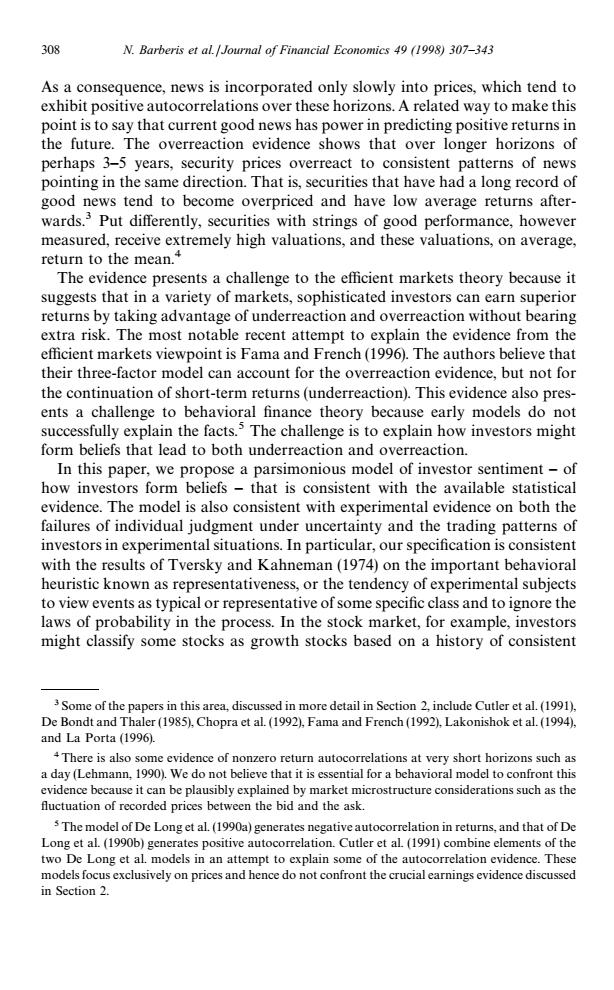正在加载图片...

308 N.Barberis et al./Journal of Financial Economics 49 (1998)307-343 As a consequence,news is incorporated only slowly into prices,which tend to exhibit positive autocorrelations over these horizons.A related way to make this point is to say that current good news has power in predicting positive returns in the future.The overreaction evidence shows that over longer horizons of perhaps 3-5 years,security prices overreact to consistent patterns of news pointing in the same direction.That is,securities that have had a long record of good news tend to become overpriced and have low average returns after- wards.3 Put differently,securities with strings of good performance,however measured,receive extremely high valuations,and these valuations,on average, return to the mean.4 The evidence presents a challenge to the efficient markets theory because it suggests that in a variety of markets,sophisticated investors can earn superior returns by taking advantage of underreaction and overreaction without bearing extra risk.The most notable recent attempt to explain the evidence from the efficient markets viewpoint is Fama and French(1996).The authors believe that their three-factor model can account for the overreaction evidence,but not for the continuation of short-term returns(underreaction).This evidence also pres- ents a challenge to behavioral finance theory because early models do not successfully explain the facts.3 The challenge is to explain how investors might form beliefs that lead to both underreaction and overreaction. In this paper,we propose a parsimonious model of investor sentiment-of how investors form beliefs-that is consistent with the available statistical evidence.The model is also consistent with experimental evidence on both the failures of individual judgment under uncertainty and the trading patterns of investors in experimental situations.In particular,our specification is consistent with the results of Tversky and Kahneman(1974)on the important behavioral heuristic known as representativeness,or the tendency of experimental subjects to view events as typical or representative of some specific class and to ignore the laws of probability in the process.In the stock market,for example,investors might classify some stocks as growth stocks based on a history of consistent 3 Some of the papers in this area,discussed in more detail in Section 2,include Cutler et al.(1991). De Bondt and Thaler(1985),Chopra et al.(1992),Fama and French (1992),Lakonishok et al.(1994), and La Porta (1996). +There is also some evidence of nonzero return autocorrelations at very short horizons such as a day (Lehmann,1990).We do not believe that it is essential for a behavioral model to confront this evidence because it can be plausibly explained by market microstructure considerations such as the fluctuation of recorded prices between the bid and the ask. sThe model of De Long et al.(1990a)generates negative autocorrelation in returns,and that of De Long et al.(1990b)generates positive autocorrelation.Cutler et al.(1991)combine elements of the two De Long et al.models in an attempt to explain some of the autocorrelation evidence.These models focus exclusively on prices and hence do not confront the crucial earnings evidence discussed in Section 2.3 Some of the papers in this area, discussed in more detail in Section 2, include Cutler et al. (1991), De Bondt and Thaler (1985), Chopra et al. (1992), Fama and French (1992), Lakonishok et al. (1994), and La Porta (1996). 4There is also some evidence of nonzero return autocorrelations at very short horizons such as a day (Lehmann, 1990). We do not believe that it is essential for a behavioral model to confront this evidence because it can be plausibly explained by market microstructure considerations such as the fluctuation of recorded prices between the bid and the ask. 5The model of De Long et al. (1990a) generates negative autocorrelation in returns, and that of De Long et al. (1990b) generates positive autocorrelation. Cutler et al. (1991) combine elements of the two De Long et al. models in an attempt to explain some of the autocorrelation evidence. These models focus exclusively on prices and hence do not confront the crucial earnings evidence discussed in Section 2. As a consequence, news is incorporated only slowly into prices, which tend to exhibit positive autocorrelations over these horizons. A related way to make this point is to say that current good news has power in predicting positive returns in the future. The overreaction evidence shows that over longer horizons of perhaps 3—5 years, security prices overreact to consistent patterns of news pointing in the same direction. That is, securities that have had a long record of good news tend to become overpriced and have low average returns afterwards.3 Put differently, securities with strings of good performance, however measured, receive extremely high valuations, and these valuations, on average, return to the mean.4 The evidence presents a challenge to the efficient markets theory because it suggests that in a variety of markets, sophisticated investors can earn superior returns by taking advantage of underreaction and overreaction without bearing extra risk. The most notable recent attempt to explain the evidence from the efficient markets viewpoint is Fama and French (1996). The authors believe that their three-factor model can account for the overreaction evidence, but not for the continuation of short-term returns (underreaction). This evidence also presents a challenge to behavioral finance theory because early models do not successfully explain the facts.5 The challenge is to explain how investors might form beliefs that lead to both underreaction and overreaction. In this paper, we propose a parsimonious model of investor sentiment — of how investors form beliefs — that is consistent with the available statistical evidence. The model is also consistent with experimental evidence on both the failures of individual judgment under uncertainty and the trading patterns of investors in experimental situations. In particular, our specification is consistent with the results of Tversky and Kahneman (1974) on the important behavioral heuristic known as representativeness, or the tendency of experimental subjects to view events as typical or representative of some specific class and to ignore the laws of probability in the process. In the stock market, for example, investors might classify some stocks as growth stocks based on a history of consistent 308 N. Barberis et al./Journal of Financial Economics 49 (1998) 307—343